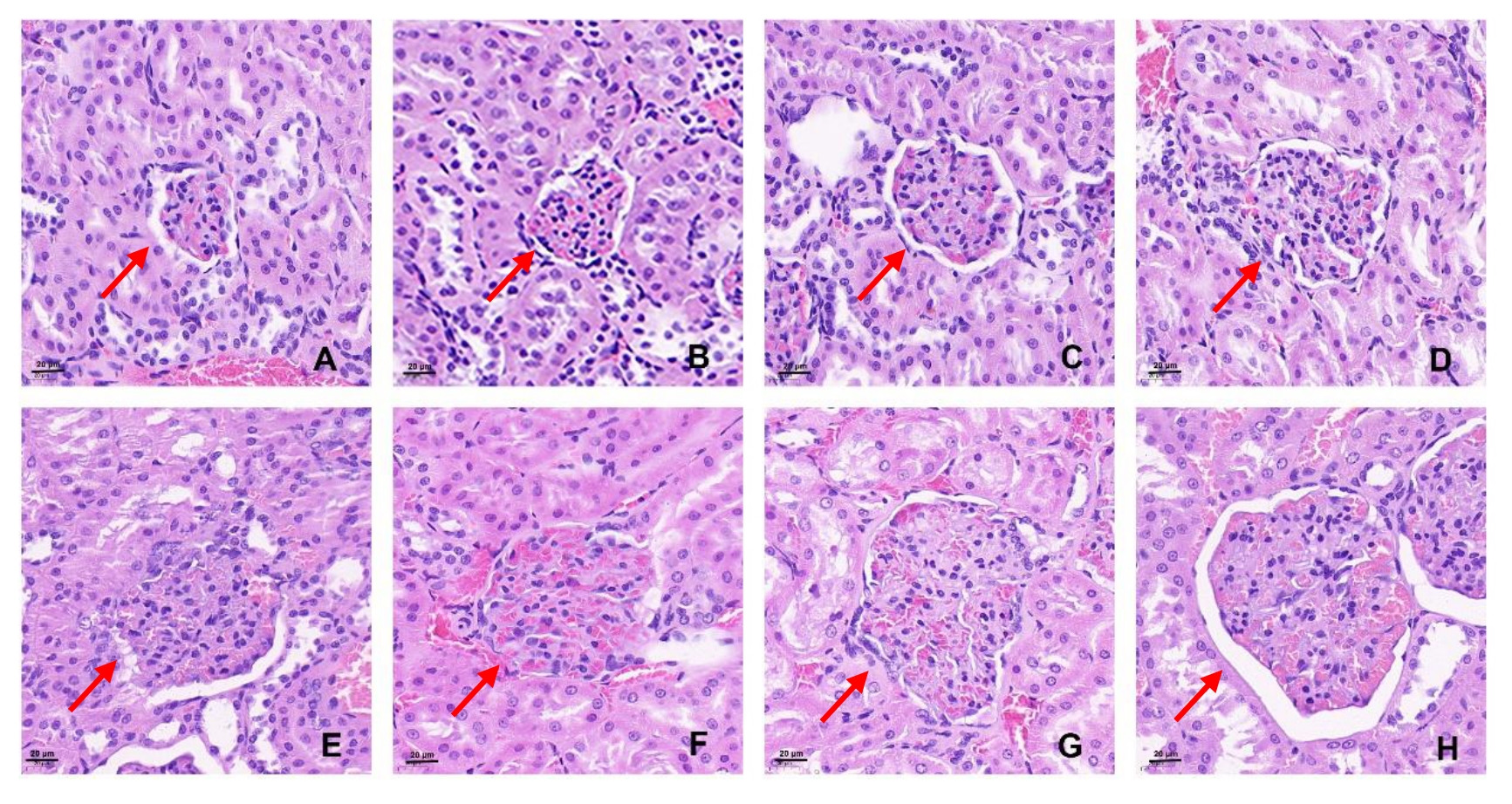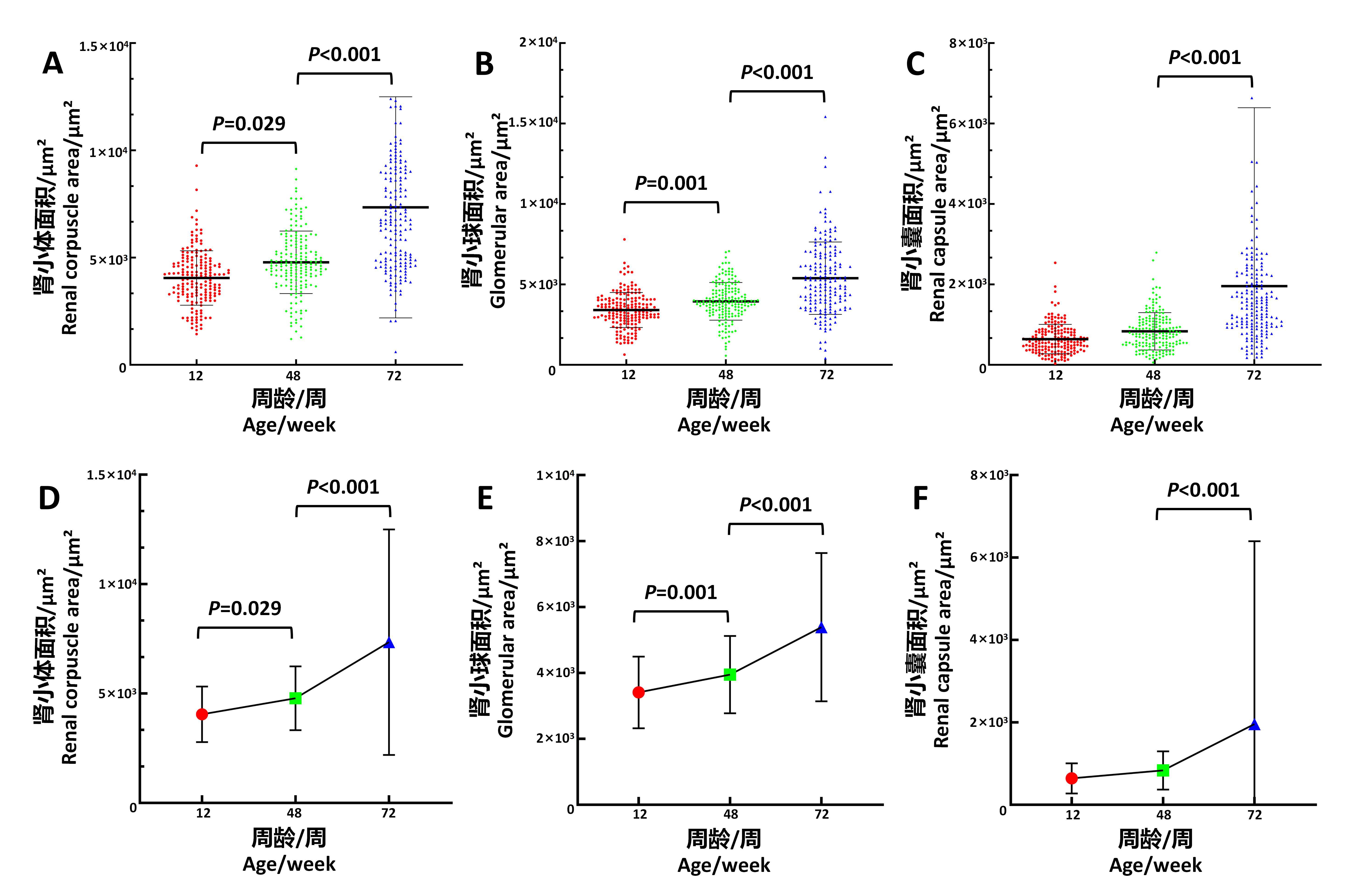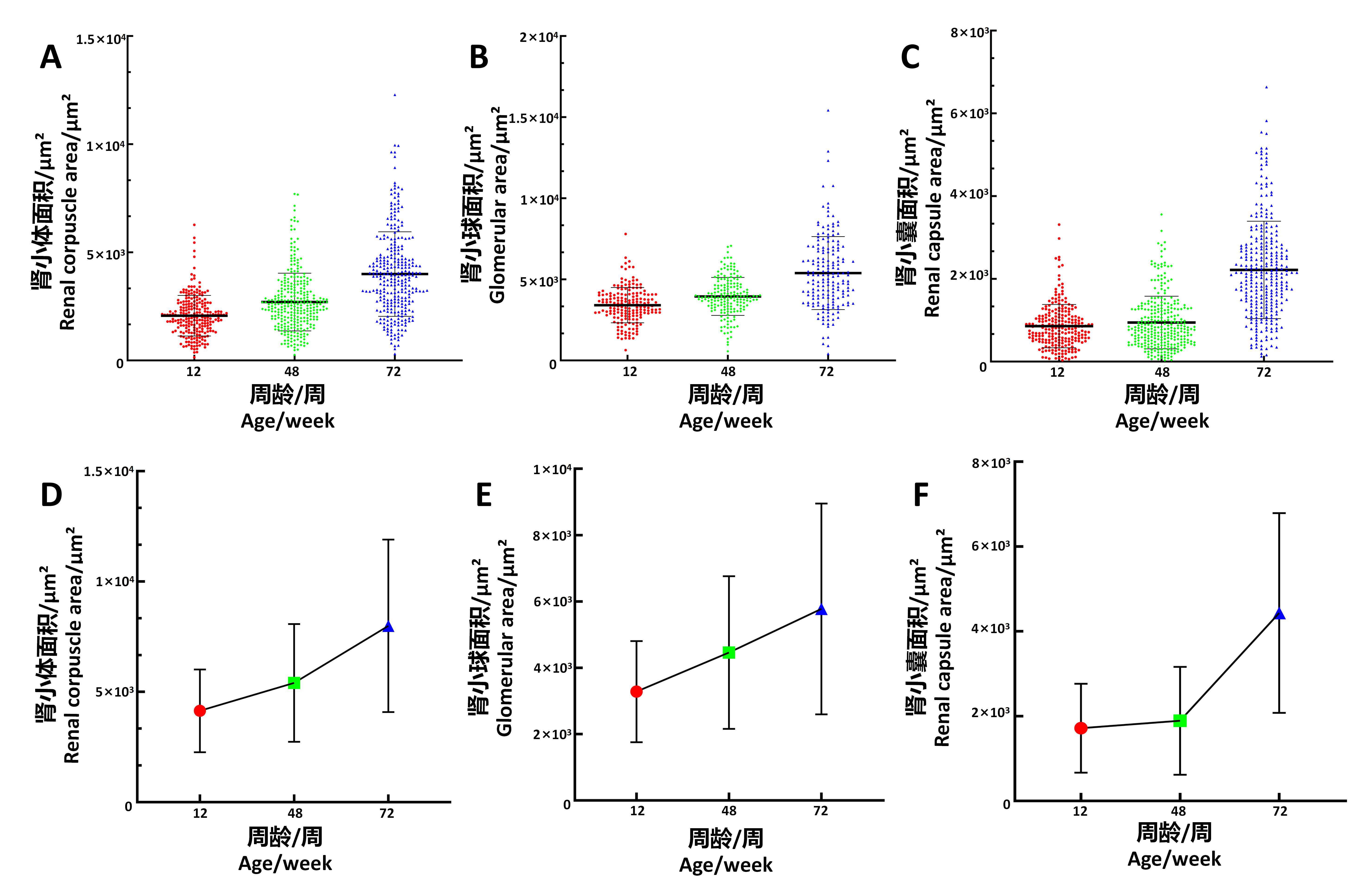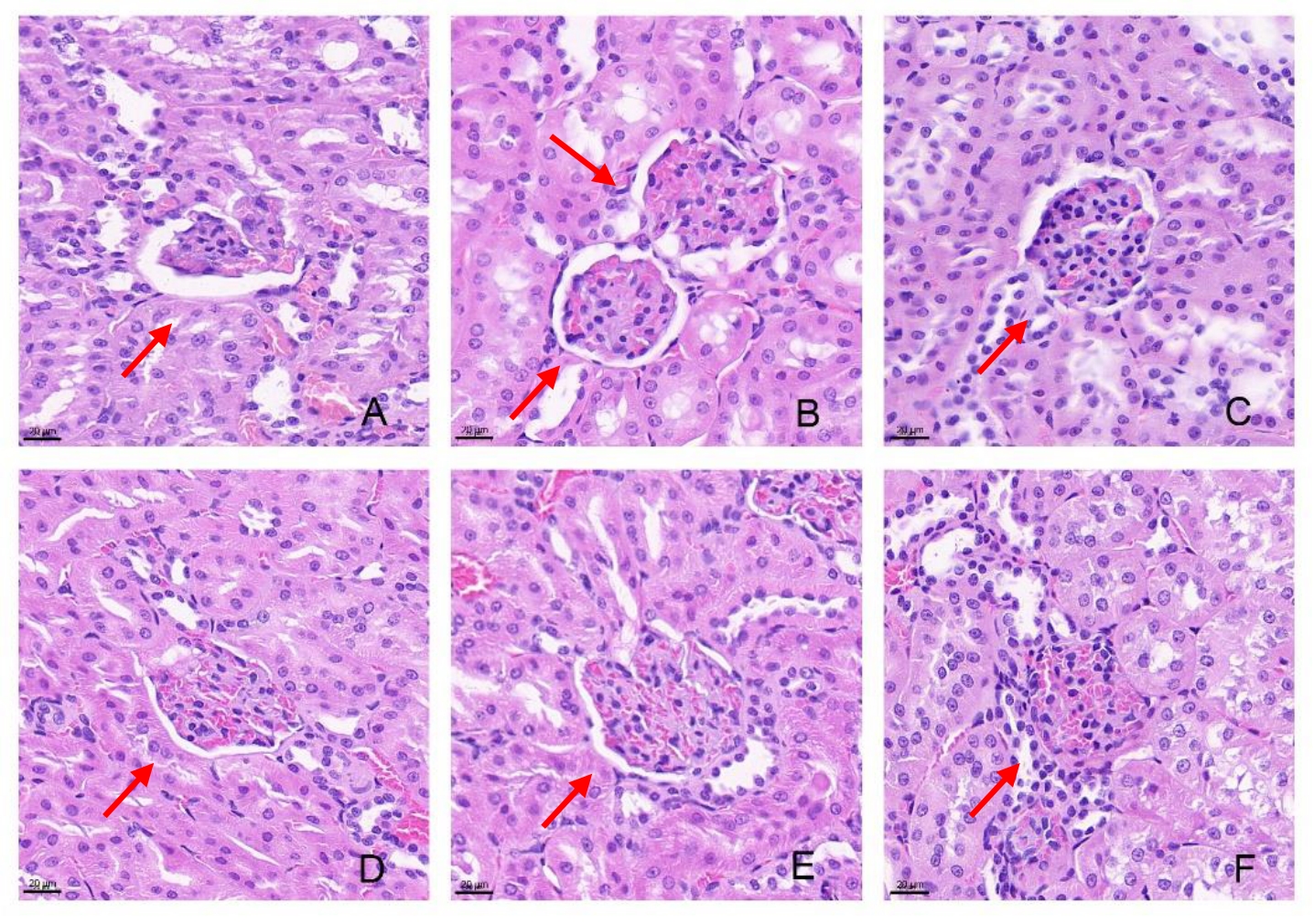
Laboratory Animal and Comparative Medicine ›› 2024, Vol. 44 ›› Issue (5): 487-494.DOI: 10.12300/j.issn.1674-5817.2024.011
• Development and Utilization of Laboratory Animal Resources • Previous Articles Next Articles
LI Meng1( ), CHEN Bai'an1,2,3, LU Jing1,2,3(
), CHEN Bai'an1,2,3, LU Jing1,2,3( )
)
Received:2024-01-16
Revised:2024-06-03
Online:2024-10-25
Published:2024-11-06
Contact:
LU Jing
CLC Number:
LI Meng,CHEN Bai'an,LU Jing. Morphological Changes of Renal Corpuscles in Male Mongolian Gerbils at Different Ages[J]. Laboratory Animal and Comparative Medicine, 2024, 44(5): 487-494. DOI: 10.12300/j.issn.1674-5817.2024.011.
Add to citation manager EndNote|Ris|BibTeX
URL: https://www.slarc.org.cn/dwyx/EN/10.12300/j.issn.1674-5817.2024.011

Figure 1 Hematoxylin and eosin staining results of renal corpuscles of different sizes in male Mongolian gerbilsNote: Images of renal corpuscles with different cross-sectional areas (the area of A-H images are 2 476.0, 3 211.0,, 5 089.6, 6 502.2, 8 534.3, 10 320.7, 13 010.6, 15 427.0, μm 2, respectively) at a magnification of 40 × 10 times (indicated by red arrows), with a scale bar size of 20 μm.

Figure 2 Comparison of sizes of renal corpuscles, glomeruli, and renal vesicles on the largest longitudinal section of the kidneys in male Mongolian gerbils of different agesNote:30 fields of view were randomly selected from each male Mongolian gerbil, and the areas of 30 sets of renal corpuscles, glomeruli, and renal vesicles were measured (n=6) ; A-C are scatter plots of renal corpuscle, glomerulus, and renal vesicle area at three age groups; D-F are trend charts of renal corpuscle, glomerulus, and renal vesicle area at three age groups.

Figure 3 Comparison of the size of renal corpuscles, glomeruli, and renal vesicles on the largest longitudinal section in a male Mongolian gerbil randomly selected from different age groupsNote: Randomly select one male Mongolian gerbil at each week of age and measure the area of all renal corpuscles, glomeruli, and renal vesicles on the largest longitudinal section of its kidney;236, 302 and 298 sets of renal corpuscles, glomeruli, and renal vesicles were measured at 12 weeks, 48 weeks, and 72 weeks respectively; A-C are scatter plots of renal corpuscle, glomerulus, and renal vesicle area; D-F are trend charts of renal corpuscle, glomerulus, and renal vesicle area.

Figure 4 Hematoxylin and eosin staining results of the different proportion of glomerular in male Mongolian gerbilsNote: Images of renal corpuscles with different proportions of glomeruli at magnification of 40 × 10 times (indicated by red arrows). A: 54.1%; B: 66.9% (bottom left)/69.9% (top right); C: 73.7%; D: 80.9%; E: 83.0%; F: 97.0%, with a scale bar size of 20 μm.

Figure 5 Comparison of the proportion of glomerular area on the largest longitudinal section of the kidneys in male Mongolian gerbils of different agesNote: A and C are scatter plots of glomerular proportions; B and D are the trend charts of glomerular proportion. A-B 30 fields of view were randomly selected from each male Mongolian gerbil, and the areas of 30 sets of renal corpuscles, glomeruli, and renal vesicles were measured (n=6) ; C-D, One male Mongolian gerbil was randomly selected at each week of age, and the area of all renal corpuscles, glomeruli, and renal vesicle of on the largest longitudinal section of the kidneys was measured. 236, 302 and 298 sets of renal corpuscles, glomeruli, and renal vesicles were measured at 12 weeks, 48 weeks, and 72 weeks respectively. The ratio of glomeruli to renal corpusde area was calculated.
| 1 | 钟民涛, 黄敏, 卢静, 等. 长爪沙鼠速发型高脂血症模型的初步建立[J]. 中国实验动物学报, 2006, 14(3):217-221. DOI: 10.3969/j.issn.1005-4847.2006.03.014 . |
| ZHONG M T, HUANG M, LU J, et al. Establishment of a rapid hyperlipidemic gerbil model[J]. Acta Lab Anim Sci Sin, 2006, 14(3):217-221. DOI: 10.3969/j.issn.1005-4847.2006.03.014 . | |
| 2 | 钟民涛, 王迎, 卢静, 等. 长爪沙鼠的高脂血症与动脉粥样硬化相关性分析[J]. 中国比较医学杂志, 2006, 16(6):321-324. DOI: 10.3969/j.issn.1671-7856.2006.06.001 . |
| ZHONG M T, WANG Y, LU J, et al. Analysis of correlation between hyperlipidemia and atherogenesis in the gerbil[J]. Chin J Comp Med, 2006, 16(6):321-324. DOI: 10.3969/j.issn.1671-7856.2006.06.001 . | |
| 3 | 李长龙, 杜小燕, 王冬平, 等. 长爪沙鼠脑缺血模型近交系的培育及其发病机制研究进展[J]. 中国实验动物学报, 2018, 26(4):512-517. DOI: 10.3969/j.issn.1005-4847.2018.04.017 . |
| LI C L, DU X Y, WANG D P, et al. Advances in research of the establishment of an inbred Mongolian gerbil model of cerebral ischemia and its mechanism of pathogenesis[J]. Acta Lab Anim Sci Sin, 2018, 26(4):512-517. DOI: 10.3969/j.issn.1005-4847.2018.04.017 . | |
| 4 | 李巍, 陈晓娟, 张旭亮, 等. 长爪沙鼠非酒精性脂肪肝肝硬化模型的建立[J]. 中国老年学杂志, 2019, 39(13):3233-3238. DOI: 10.3969/j.issn.1005-9202.2019.13.048 . |
| LI W, CHEN X J, ZHANG X L, et al. Establishment of a Mongolian gerbil model of nonalcoholic fatty liver disease cirrhosis[J]. Chin J Gerontol, 2019, 39(13):3233-3238. DOI: 10.3969/j.issn.1005-9202.2019.13.048 . | |
| 5 | 杜小燕, 李长龙, 王冬平, 等. 长爪沙鼠自发性糖尿病模型近交系培育及其生物学特性的研究进展[J]. 中国实验动物学报, 2018, 26(4):507-511. DOI: 10.3969/j.issn.1005-4847.2018.04.016 . |
| DU X Y, LI C L, WANG D P, et al. Research progress in the establishment of a spontaneous diabetic inbred gerbil and its biological characteristics[J]. Acta Lab Anim Sci Sin, 2018, 26(4):507-511. DOI: 10.3969/j.issn.1005-4847.2018.04.016 . | |
| 6 | 李振宗, 赵晖, 曹琦, 等. ND3、NF-κB在遗传性糖尿病长爪沙鼠肝脏、肾脏中的表达定位[J]. 实验动物科学, 2018, 35(6):1-6. DOI: 10.3969/j.issn.1006-6179.2018.06.001 . |
| LI Z Z, ZHAO H, CAO Q, et al. Localization of ND3 and NF-κB on livers and kidneys from hereditary diabetic Mongolian gerbils[J]. Lab Anim Sci, 2018, 35(6):1-6. DOI: 10.3969/j.issn.1006-6179.2018.06.001 . | |
| 7 | 李胜利, 乔欣, 王钜. 海人酸致沙鼠癫痫模型初探[J]. 实验动物科学与管理, 2006, 23(4):16-17. DOI: 10.3969/j.issn.1006-6179.2006.04.006 . |
| LI S L, QIAO X, WANG J. The primary study on the establishment of a model of epilepsy induced by kainic acid in gerbils[J]. Lab Anim Sci Manag, 2006, 23(4):16-17. DOI: 10. 3969/j.issn.1006-6179.2006.04.006 . | |
| 8 | 宋丹丹, 桂飞, 汪海燕, 等. 长爪沙鼠不同感音神经性耳聋模型的建立及比较[J]. 石河子大学学报(自然科学版), 2024, 42(1):70-75. DOI: 10.13880/j.cnki.65-1174/n.2023.22.043 . |
| SONG D D, GUI F, WANG H Y, et al. Establishment and comparison of sensorineural deafness models in Mongolian gerbils[J]. J Shihezi Univ Nat Sci, 2024, 42(1):70-75. DOI: 10.13880/j.cnki.65-1174/n.2023.22.043 . | |
| 9 | 叶瑞, 王莉君, 李先春, 等. 长爪沙鼠及其寄生虫感染模型组学研究进展[J]. 动物医学进展, 2023, 44(8):97-101. DOI: 10.16437/j.cnki.1007-5038.2023.08.014 . |
| YE R, WANG L J, LI X C, et al. Progress on omics of Mongolian gerbil and its parasite infection models[J]. Prog Vet Med, 2023, 44(8):97-101. DOI: 10.16437/j.cnki.1007-5038.2023.08.014 . | |
| 10 | 伍颖, 王诗媛, 胡彩姣, 等. Cystatin C敲除诱导的长爪沙鼠抑郁模型[J]. 生物化学与生物物理进展, 2022, 49(5):907-916. DOI: 10.16476/j.pibb.2022.0115 . |
| WU Y, WANG S Y, HU C J, et al. Knockout of cystatin C induced depression model in gerbils[J]. Prog Biochem Biophys, 2022, 49(5):907-916. DOI: 10.16476/j.pibb.2022.0115 . | |
| 11 | 马兰芝, 李迎, 尚世臣, 等. CMU/1和CMU/2近交系长爪沙鼠脏器系数的比较[J]. 实验动物科学, 2019, 36(4):60-62, 67. DOI: 10.3969/j.issn.1006-6179.2019.04.014 . |
| MA L Z, LI Y, SHANG S C, et al. Comparison of the viscera coefficient of CMU/1 and CMU/2 inbred strains of gerbil[J]. Lab Anim Sci, 2019, 36(4):60-62, 67. DOI: 10.3969/j.issn.1006-6179.2019.04.014 . | |
| 12 | 王钜, 卢静, 陈振文, 等. 清洁级长爪沙鼠主要器官重量的测定[J]. 中国比较医学杂志, 2004, 14(4): 221-223. DOI: 10.3969/j.issn.1671-7856.2004.04.007 . |
| WANG J, LU J, CHEN Z W, et al. Mensuration of main visceral weight in clean Mongolian gerbils[J]. Chin J Lab Anim Sci, 2004, 14(4): 221-223. DOI: 10.3969/j.issn.1671-7856.2004.04.007 . | |
| 13 | 卢领群, 郭红刚, 石巧娟, 等. 不同月龄长爪沙鼠的肾脏组织学特征[J]. 实验动物与比较医学, 2023, 43(1):61-66. DOI: 10.12300/j.issn.1674-5817.2022.130 . |
| LU L Q, GUO H G, SHI Q J, et al. Histological characteristics of the kidney in Mongolian gerbils of different ages[J]. Lab Anim Comp Med, 2023, 43(1):61-66. DOI: 10.12300/j.issn.1674-5817.2022.130 . | |
| 14 | PANNARALE G, CARBONE R, DEL MASTRO G, et al. The aging kidney: structural changes[J]. J Nephrol, 2010, 23(): S37-S40. |
| 15 | GOYAL V K, CHATTERJEE P C. Changes with age in mouse kidney[J]. Exp Gerontol, 1980, 15(3):151-160. DOI: 10.1016/0531-5565(80)90059-5 . |
| 16 | 秦川, 谭毅. 医学实验动物学[M]. 3版. 北京: 人民卫生出版社, 2020: 75. |
| QIN C, TAN Y. Medical laboratory animal science [M]. 3rd. Beijing: People's Medical Publishing House, 2020: 75. | |
| 17 | SENGUPTA P. The laboratory rat: relating its age with human's[J]. Int J Prev Med, 2013, 4(6):624-630. |
| [1] | . [J]. Laboratory Animal and Comparative Medicine, 2024, (): 1-4. |
| [2] | ZHAO Lijuan, XIAO Chunlan, SHENG Yajie, LU Xi, ZHOU Zhengyu. Half a Century of Struggle and Fifty Years of Development in Suzhou laboratory Animal Industry [J]. Laboratory Animal and Comparative Medicine, 2024, (): 1-9. |
| [3] | TAO Lingyun. Analysis of the Genetic Characteristics of Feline Coronavirus and Research Progress [J]. Laboratory Animal and Comparative Medicine, 2024, (): 1-6. |
| [4] | . [J]. Laboratory Animal and Comparative Medicine, 2024, 44(5): 583-586. |
| [5] | CHEN Bing, ZOU Yixing, WANG Jingdong. Analysis on Current Status and Countermeasures for Laboratory Animal Management in Sichuan Province Based on Administrative Licensing [J]. Laboratory Animal and Comparative Medicine, 2024, 44(5): 560-566. |
| [6] | ZHENG Qingyong, LI Tengfei, XU Jianguo, ZHOU Yongjia, MA Zhichao, WANG Na, LI Molan, YANG Wenjing, WU Peirun, WANG Haidong, TIAN Jinhui. Advances and Challenges in the Research of Integration Methods of Animal Experimental Evidence [J]. Laboratory Animal and Comparative Medicine, 2024, 44(5): 567-576. |
| [7] | DU Xiaoyan, LIU Yunbo. Analysis of the Progress in Identification and Evaluation of Laboratory Animal Resources in China [J]. Laboratory Animal and Comparative Medicine, 2024, 44(5): 469-474. |
| [8] | . [J]. Laboratory Animal and Comparative Medicine, 2024, 44(4): 463-466. |
| [9] | DENG Shaochang, LIN Danrong, LIANG Chujun, LEI Weiqiao, YANG Jinchun, ZHAO Weibo. Analysis of Institutional Characteristics and Implementation of Guangdong Province Laboratory Animals Ordinance in the Past Decade [J]. Laboratory Animal and Comparative Medicine, 2024, 44(4): 455-462. |
| [10] | ZHAO Yong. Three Dimensions of Animal Experiment Ethics: Analysis Based on Value of Life, Animal Welfare, and Risk Prevention [J]. Laboratory Animal and Comparative Medicine, 2024, 44(4): 445-454. |
| [11] | KONG Chuiqin, TIAN Miaomiao, CAI Lidong, WU Dong, NI Lu, ZHANG Chuman, YANG Huixin. Exploration on Application Effectiveness of Microbial Capture Filter Membranes from Different Materials in Barrier Environment Facilities [J]. Laboratory Animal and Comparative Medicine, 2024, 44(4): 436-444. |
| [12] | WU Xiansheng, HUANG Wei, LIANG Yongfen, DENG Hui, ZHAI Yonghuan, YANG Jiajun, HUANG Ganquan, WANG Gang. Analysis of Breeding and Application Data for Laboratory Cats [J]. Laboratory Animal and Comparative Medicine, 2024, 44(4): 428-435. |
| [13] | WU Yue, LI Lu, ZHANG Yang, WANG Jue, FENG Tingting, LI Yitong, WANG Kai, KONG Qi. Integrative Analysis of Omics Data in Animal Models of Coronavirus Infection [J]. Laboratory Animal and Comparative Medicine, 2024, 44(4): 357-373. |
| [14] | SUN Qiang. History, Current Status, Challenges and Opportunities of Laboratory Monkey Industry in China [J]. Laboratory Animal and Comparative Medicine, 2024, 44(4): 343-356. |
| [15] | . [J]. Laboratory Animal and Comparative Medicine, 2024, 44(3): 335-338. |
| Viewed | ||||||
|
Full text |
|
|||||
|
Abstract |
|
|||||